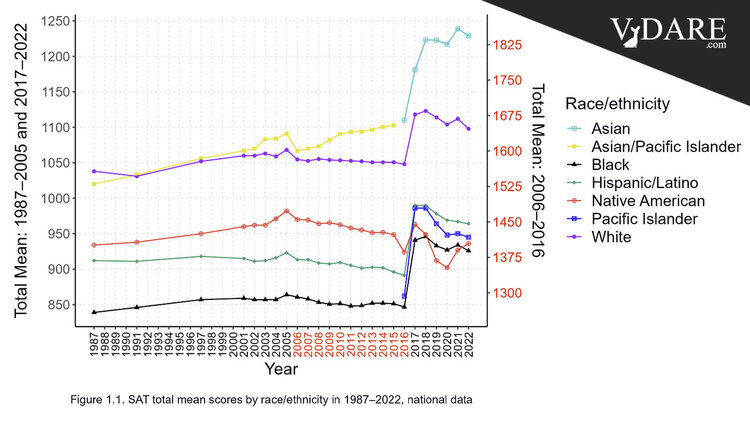


By Steve Sailer
08/10/2023
Everybody complains about the college admissions process, but practically nobody ever looks into college admissions tests to see if they could be improved or even if, as they appear to be, are getting worse. That’s probably because:
A. Thinking about the SAT and the like is hard.
B. The big racial gaps in test scores are, even more than in the past, society’s Forbidden Topic, so it’s possible that anybody respectable who looks into whatever is going on with the SAT will get himself canceled.
So, we have this situation where David Coleman gets unaccountable power over the SAT test because he’d earlier sold Bill Gates on the Common Core. And Gates had bought off most of the educational thinktanks in America with generous donations. So when Gates decided he liked the Common Core, everybody jumped on board across the country without pausing to test it first.
Because the Common Core was riding so high about a decade ago (it has largely been forgotten today as the billionaire-driven Ed Reform mania of the early 21st century has vanished), the College Board hired Coleman to make the SAT reflect the Common Core. So Coleman rolled out a big change in the SAT in 2017, with some unexpected results: notably, Native American scores plummeted and Asian scores skyrocketed.
From Human Varieties, a deep dive into SAT scores, especially in the eleven states where the government pays for everybody to take the college admission test.
The SAT and Racial/Ethnic Differences in Cognitive Ability
JULY 26, 2023 / DALLIARD / 2 COMMENTS
Here are scores by state by race, with high SAT participation states (at least 98%) sorted in order of average white scores (e.g., West Virginia lowest, District of Columbia highest):


There’s all sorts of good stuff in is this long posting, such as why Asian scores have gotten so high after David Coleman’s revamp of the SAT in 2017, so I encourage those who are interested in the subject to dig in.
My guess is that Coleman tried to boost black and Hispanic scores with his new look 2017 SAT.

Black and Hispanic scores are up some relative to whites since then, but Asian scores on the SAT suddenly went through the roof.
The NAEP and PISA results lend support to the argument that the current SAT version may somewhat overestimate the cognitive ability of Asian Americans. The post-2017 gains seen by Asians in the SAT are unlikely to be purely gains in ability. Without the test redesign, Asians would have grown their lead over whites and others at a slower rate, given the test score gap trends seen during the previous SAT versions.
Heckuva job, David!
Here’s a fun bit: What if the top score on the SAT was greater than 1600? How many people per million would score above 1600? Here are Dalliard’s estimates:

Per million, there would be 7,000 times more Asians scoring over 1600 than blacks. Our society is obsessed with getting more blacks in far right tail of the bell curve jobs like astrophysicist, but it’s a little hard to say how that goal is compatible with massive Asian immigration, yet that never occurs to anybody in the media.
Some of Dalliard’s summary:
Racial/ethnic differences in the SAT are largely coterminous with IQ differences. There are some exceptions to this pattern, however, especially when it comes to Asian-Americans and Native Americans in recent years.
The current version of the SAT that was first taken by the high school class of 2017 favors Asians compared to earlier tests. It is not clear why this is the case, but the redesign appears to have boosted Asian total score performance by about d = 0.20 in relation to whites and others. This conclusion is supported by several lines of evidence, such as:
In the national SAT time series, Asians had been slowly and steadily gaining on whites for decades, but after 2017 the gains accelerated considerably.
In states where SAT participation remained at the same level before and after 2017, the Asian-white gap suddenly grew by about d = 0.20 after the new SAT was introduced.
Before 2017, the Asian-white SAT gap was similar to the gap seen in other IQ tests. After 2017, the SAT gap has grown to be substantially larger than in other tests.
The causes of the larger than expected Asian gains are unknown. Changes in item contents and scoring may have made the test more coachable, but no hard evidence for this exists.
Native Americans are the worst-performing racial/ethnic group in the SAT these days. The SAT appears to underestimate the cognitive ability of Native Americans compared to other groups because they perform substantially better in other tests (e.g., SEDA and NAEP).
In the national SAT data, blacks and Hispanics have gained modestly on whites after 2017. However, these gains are not observed in states where SAT participation has remained constant. The apparent gains are probably explainable by selection bias, viz., changes in the size and composition of the national test-taker cohorts. Black-white and Hispanic-white SAT gaps in states where SAT participation is universal are very similar to gaps in other IQ tests.
There’s lots more good stuff in Dalliard’s write-up.